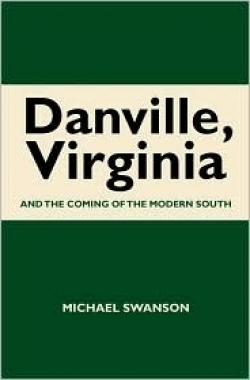Danville, Virginia
and the Coming of the Modern South
In Danville, Virginia, and the Coming of the Modern South, Michael Swanson offers the fascinating history of a tiny Southern hamlet, from the dissolution of the Secessionist government of Jefferson Davis, to the rough-and-tumble politics and low wage jobs that characterized the town in the 1940s. A veteran writer with a master’s degree in history from the University of Virginia, Swanson deftly illustrates that the South’s racial upheaval, and rapid changes in the 1960s, were actually due to events that occurred as long ago as the fall of the Confederacy, and continued through the 1940s. In crisp prose, the author spotlights Danville as emblematic of the post-war South’s struggle to regain economic viability, while simultaneously grappling with race-related conflict.
Swanson’s finesse at creating a narrative using primary source materials, allows readers to feel as though they are witnessing history, instead of merely reading about it. For instance, when Swanson cites senate testimony about the Danville riots, the direct quotes will fling readers back to that tense day. In fact, Danville is jammed full of so many primary sources, that it reads like a fun novel, instead of dragging on like the stereotypical dry, pedantic history tome.
Although this delightful volume is a quick read, readers will learn much from its authoritative pages. Numerous footnotes confirm that the author conducted scholarly research, and expertly cited the works of others to support his conclusions. Those unfamiliar with race relations in the South will be surprised to learn that some whites and blacks were actually allies during the Reconstruction. Readers will also discover the devious ways in which the whites in power tried to turn the races against each other. For example, in an effort to deny black men the vote, the powerful whites imposed rules that effectively stopped many whites from voting as well.
In addition, readers get firsthand accounts of the harrowing lives of Danville millworkers, as they chose between keeping their dangerous jobs or getting fired while trying to organize a union. Through examples like these, Swanson effectively hammers home the themes of contentious race relations, and the few having power over the many. Although circumstances have changed since the period about which Swanson writes, readers will still make connections to similar modern events because of the author’s economical prose. While much of the book is about the doings of white men, the author does include women and people of color, using direct quotations whenever possible. In short, Swanson has achieved a marvelous feat: he has written an entertaining and scholarly book, to be enjoyed by anyone.
Reviewed by
Jill Allen
Disclosure: This article is not an endorsement, but a review. The publisher of this book provided free copies of the book and paid a small fee to have their book reviewed by a professional reviewer. Foreword Reviews and Clarion Reviews make no guarantee that the publisher will receive a positive review. Foreword Magazine, Inc. is disclosing this in accordance with the Federal Trade Commission’s 16 CFR, Part 255.

